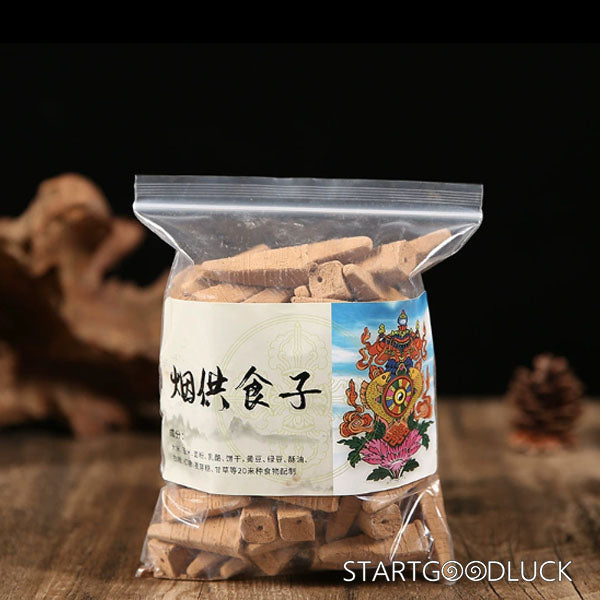These are Buddhist Smoke Offering Tsok (also known as “incense cones for smoke offerings”). Crafted for traditional Sang rituals, they come in two variants: the original natural - flavored type and a special “Milky Aroma” version. Made with care from natural ingredients, each cone carries the essence of Buddhist practice, serving as a bridge between the physical and spiritual realms in your religious ceremonies.
What It Is
In Tibetan Buddhism, “Tsok” (烟供食子 in Chinese) is a key element of Sang Offerings—a practice where burning substances release smoke as offerings to enlightened beings (like Buddhas, Bodhisattvas) and to care for sentient beings in subtle dimensions. These cones are shaped for easy burning, and their smoke symbolizes transforming ordinary energy into sacred devotion, carrying prayers and positive intentions.
How to Use
Prepare the Altar: Choose a clean, quiet space. Place a heat - resistant incense burner or a dedicated Sang offering stove. Ensure good ventilation and keep flammable items away.
Place the Cone: Take 1 - 3 cones (adjust based on your ritual needs) and set them in the burner. The cone shape helps them burn steadily without extra tending.
Ignite with Reverence: Light the tip of the cone. Let the flame catch briefly, then blow it out gently—you only need the smoldering smoke. As you do this, focus your mind and quietly recite prayers or mantras (e.g., “Om Mani Padme Hum” or other personal/tradition - specific chants).
Meditate & Offer: Watch the smoke rise. Visualize it carrying your respect, gratitude, and wishes to the spiritual realm. Stay in a peaceful, devout state, praying for peace, compassion, and the well - being of all beings.
Effects & Significance
Spiritual Connection: The smoke is believed to reach enlightened beings, inviting their blessings. It’s a way to express devotion, seek guidance, and align your heart with Buddhist teachings of compassion and wisdom.
Benefiting Sentient Beings: In Buddhist belief, the smoke nourishes subtle - realm beings, sharing positive energy and helping alleviate suffering. It’s an act of universal kindness, echoing the principle of “benefiting all sentient beings.”
Inner Cultivation: Performing the ritual cultivates mindfulness, humility, and focus. The process calms the mind, deepens your spiritual practice, and reminds you of the interconnectedness of all life—encouraging you to live with more compassion and purpose.

